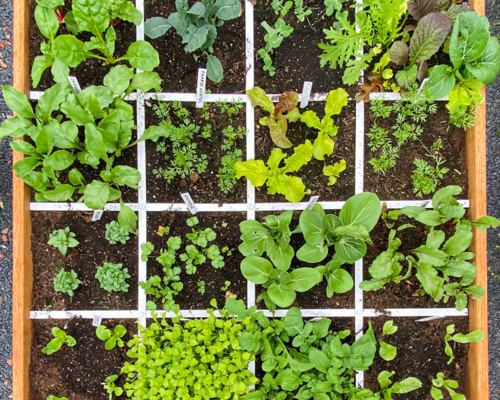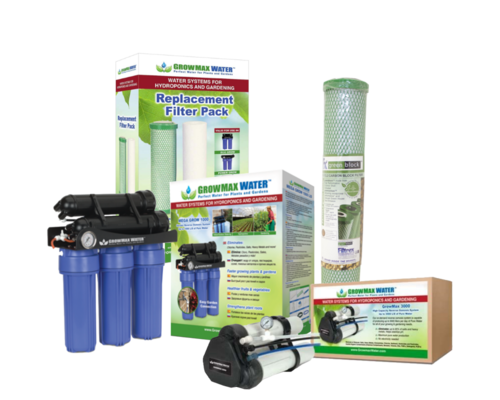What is a substrate?
A substrate consists of material that serves as a substrate for the growth and development of your crop. It acts as a medium for water, air and nutrients for the plant's roots. A growing substrate can consist of different materials, such as soil, coconut fiber, clay pellets or inert substrates such as perlite, vermiculite or rockwool. The composition of a substrate varies depending on the purpose and specific needs of the plants.
Grow substrates are the materials on which plants are grown and play an important role in the growth and development of your crop. There are several types of growing substrates available, each with its own unique properties and benefits. Below we discuss the most popular growing substrates.
Types of growing substrates
Soil: Soil is a traditional growing medium and one of the most commonly used growing substrates. It is cheap and readily available, but it is not always ideal for your grow because it does not always provide adequate drainage and is sometimes full of weeds and pathogens.
Coco: Coco is one of the most popular growing substrates and is often used for growing orchids, palms and other tropical plants. It is environmentally friendly, durable and provides excellent drainage and airiness.
Perlite: Perlite is a mineral often used in combination with other growing substrates to improve drainage. It is inexpensive and readily available, but it is also light and not very sturdy, so it is not suitable for supporting heavy plants.
Vermiculite: Vermiculite is a mineral often used in combination with soil and perlite to improve water retention. It absorbs water and gradually releases it to the plants, giving the plants the right amount of water without flooding.
Clay pellets: Clay pellets are granules used as a growing medium for hydroponics. They offer excellent drainage and airiness and are easy to keep clean, but they are also more expensive than other growing substrates but also last longer.
Sowing & cutting soil: Sowing and cutting soil is a type of soil mixture specially designed for sowing and cutting plants. It contains a combination of ingredients, such as vermiculite, peat and compost, that provide good drainage, water absorption and nutrition for young plants. This soil is airier and lighter than regular soil, which is conducive to root development and crop growth.
We offer different types of growing substrates, each with its own advantages and disadvantages, it is important to choose the right growing medium depending on the specific needs of your crop. If you are unsure about which growing medium is best for your plants, below we cover the advantages and disadvantages of each type of substrate.
Advantages and disadvantages of growing on soil
Advantages of growing on soil:
- Soil is a natural medium that has been the best known for many years. It often contains natural nutrients necessary for the healthy growth of your crop.
- Soil is inexpensive compared to other growing substrates.
- It offers good water and air retention, which is important for root health and avoiding over- or underwatering.
Disadvantages of growing on soil:
- Soil can deplete nutrients quickly, requiring regular fertilization.
- It can compact, limiting air circulation and water permeability of the substrate; this can lead to over- or underwatering.
- Soil can contain fungi and bacteria, which can harm plant health.
- It is difficult to accurately regulate the pH of soil, which is important for plant uptake of nutrients.
Advantages and disadvantages of growing on coco
Advantages of growing on coco:
- Coco is a porous substrate that offers excellent water and air retention, which is important for root health and avoiding over- or underwatering.
- Coco is durable and can withstand multiple growth cycles without needing to be replaced.
- Coco is a neutral medium and does not affect the pH level of the water, meaning it is easier to maintain the proper pH level for plant uptake of nutrients.
Disadvantages of growing on coco:
- Coco is more expensive than other growing substrates, such as soil.
- It does not contain natural nutrients and requires regular fertilization.
- Coco is not biodegradable.
- It is more difficult to determine when to replace coir because it does not show visual signs of depletion.
Advantages and disadvantages of growing on clay pellets
Advantages of growing on clay pellets:
- Clay pellets have excellent water and air retention, which is important for root health and avoiding over- or underwatering.
- Clay pellets are a stable and neutral medium and do not affect the pH level of the water, meaning it is easier to maintain the proper pH level for plant uptake of nutrients.
- Clay pellets are durable and can withstand several growth cycles without needing to be replaced.
Disadvantages of growing on clay pellets:
- Clay pellets are not biodegradable.
- Clay pellets do not contain natural nutrients and require regular fertilization.
- Clay pellets can be heavy and difficult to move, especially when wet.
- It can be difficult to determine when clay pellets need to be replaced.
Advantages and disadvantages of growing on rockwool
Advantages of growing on rockwool:
- Rockwool is a hydroponic medium that offers excellent water and air permeability, which is important for root health and avoiding over- or underwatering.
- Rockwool is lightweight and easy to move.
- Rockwool is pH neutral and does not affect the pH level of water, meaning it is easier to maintain the proper pH level for plant nutrient uptake.
Disadvantages of growing on rockwool:
- Rockwool does not contain natural nutrients and requires regular fertilization.
- It can be difficult to determine when to replace rockwool because it shows no visual signs of depletion.
- Rockwool is prone to rot and mold growth if not properly maintained.
- It is important to treat rockwool to reduce pathogens and prevent the growth of harmful microorganisms.
- Rockwool is not biodegradable
Advantages and disadvantages of sowing & cutting soil
Advantages of sowing and cutting soil:
- Good water and moisture balance: the soil provides a balanced distribution of water and moisture, which is important for the growth of young plants.
- Light and airy: the composition of the soil ensures that it is light and airy, allowing the roots of young plants to grow freely.
- Nutrients: the soil contains compost and other useful substances for plant growth.
Disadvantages of seedling soil:
- Costly: compared to regular soil, seedling soil is often more expensive.
- Can dry out quickly: due to its lighter composition, the soil is more susceptible to drying out, which can be detrimental to the growth of young plants.
- Can acidify quickly: excessive water use can cause the soil to acidify quickly, which is detrimental to plant growth.
Do you want more information?
Want more information on a specific topic? Check our "Knowledge Center" blog page to see if the information you need is among them. Is the information not in one of our blogs? We have a piece of text with each category where the products are explained in broad terms. The most popular categories are:




